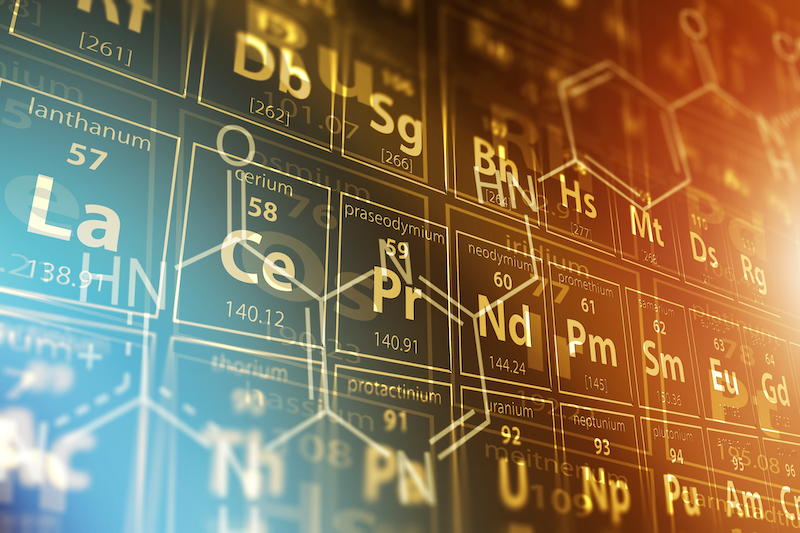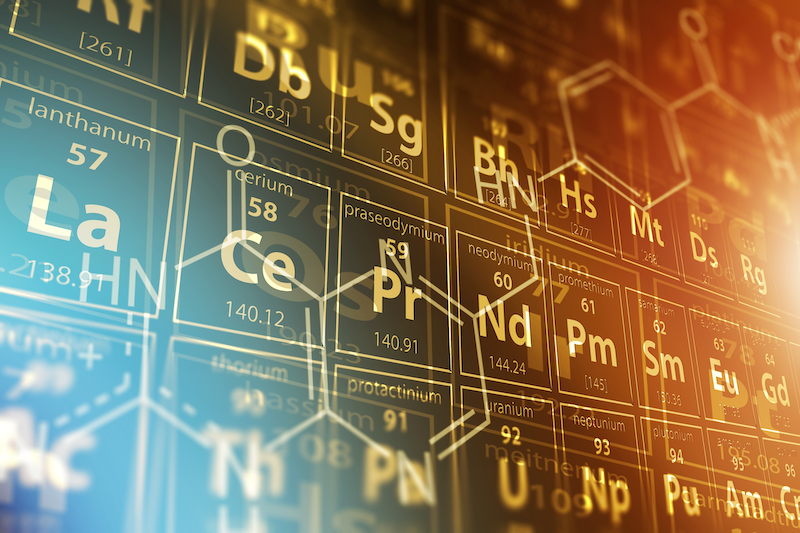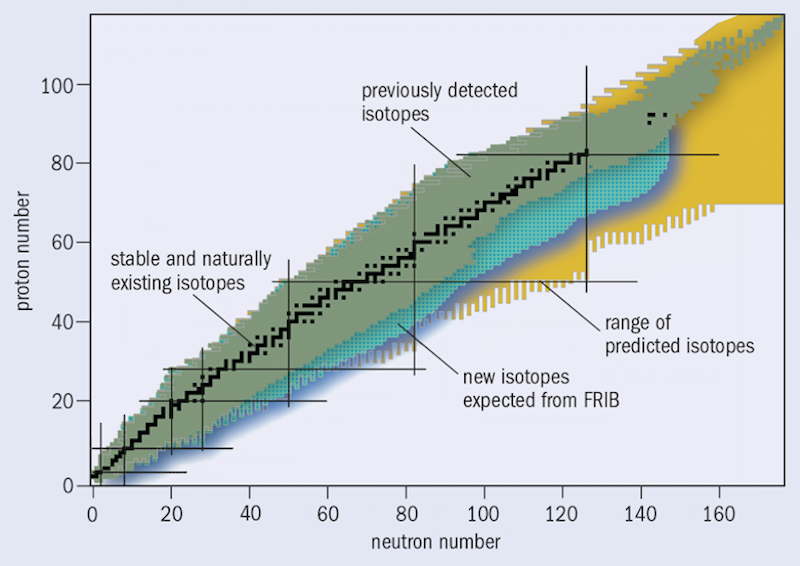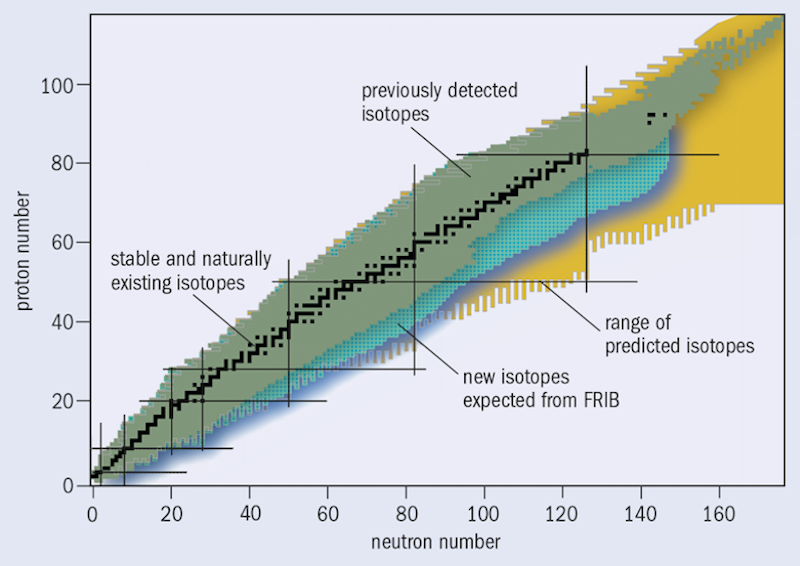Rare Isotopes for the Choosing
The nuclear physics community is hailing the kickoff of a long-awaited facility for producing beams of radioactive isotopes, with a cohort of users gearing up for the first experiments. The Facility for Rare Isotope Beams (FRIB) at Michigan State University opens its doors to experimenters this week. FRIB is expected to deliver the widest range of rare isotopes of any existing facility, including many never-before-synthesized isotopes. The facility will also allow researchers to control the energies of the isotope beams so that they match those relevant to nuclear processes in stars and supernovae.
Rare isotopes get their name from their scarcity—these unstable nuclei decay radioactively and thus cannot be found naturally on Earth. But making sizable quantities of these elements in a lab will allow scientists to tackle important open problems in physics. Current nuclear theories, for instance, can’t describe many nuclei, and rare isotopes provide extreme cases on which to test why such theories fail. Rare isotopes are also relevant to the cosmic nucleosynthesis of heavy elements, a process for which there isn’t yet a satisfactory explanation. On the applied side, radioactive isotopes can be useful for medical imaging, cancer treatment, and other industrial applications.
In light of these motivations, physicists have been pushing for a rare-ion facility for decades. In 2008, the US Department of Energy and Michigan State University awarded funds to the FRIB project, and construction started in 2014. Despite the challenges of the COVID pandemic, construction was completed early this year, a few months ahead of schedule, says FRIB’s science director Bradley Sherrill.
FRIB relies on a powerful linear accelerator, which accelerates ions to about half the speed of light and then smashes them onto a target of heavier nuclei. There, the ions react with other nuclei, producing a whole slew of different isotopes. Using a “fragment separator,” researchers can filter out desired isotopes and deliver them to “stopping stations,” where the fast beams are slowed down in a gas. This reduced speed allows the isotopes to be probed with high-precision techniques, such as laser spectroscopy. The stopped isotopes can then be reaccelerated and delivered to other experimental chambers at desired energies.
Two key aspects make FRIB a unique facility, says Sherrill. The first is the superconducting linear accelerator, which can achieve the highest beam power of any heavy-ion-accelerator facility. The machine’s efficiency is boosted by the ability to accelerate up to five ionization states of a given element, such as uranium. (Other accelerators are typically designed to only accelerate ions with a specific charge.) The second aspect is the reacceleration stage, where the speed of the produced isotopes can be precisely set. “The isotopes may be created at half or two thirds of the speed of light, but we actually want to slow them down to energies that are relevant to astrophysics,” he says.
FRIB’s beam power will “give us the furthest reach into the rarest isotopes,” says Sherrill. FRIB is expected to generate hundreds of never-before-synthesized isotopes, some of which are especially prized by scientists. “The process that developed the scientific case for FRIB identified certain key regions of isotopes, and we directed our efforts to provide access to these particular isotopes,” says Sherrill. These regions include isotopes at the limits of nuclear stability, such as those close to the neutron “drip line,” and isotopes relevant to heavy-element formation in the cosmos.
The neutron drip line marks, in the nuclide chart, the border between bound and unbound isotopes of a given element. If more neutrons are added to a nucleus at the drip line, they leak, or drip, out of the nucleus. Today, this boundary is only known for the ten lightest elements, up to neon, but FRIB’s ability to deliver neutron-rich isotopes should allow researchers to extend the drip line to tens of heavier elements. “It will take us to places where we have asked questions and didn’t get answers for decades,” says nuclear physicist Ani Aprahamian, who chairs FRIB’s program advisory committee. Her hope is that understanding these extreme cases will allow researchers to develop a unified nuclear theory that applies to nuclei of all stripes and colors.
And while isotopes at the limit of stability aren’t found on Earth, they are involved in the production of heavy elements in stars and supernovae. Many of those elements are thought to arise from the so-called r-process, which involves rapid neutron-capture reactions. The details of the r-process are poorly understood, in part because of the challenges in performing experiments under the same conditions found in the cosmos. FRIB will offer unprecedented capabilities to mimic astrophysical scenarios by making most of the isotopes that may be present in a stellar environment and by accelerating them to relevant energies, says nuclear astrophysicist Kelly Chipps from Oak Ridge National Laboratory in Tennessee. She says that a unique feature of FRIB is that it can produce different isotopic isomers—versions of the same isotopes in different energy states. Most models for the r-process assume that isomers have no effect, but “there isn’t any good reason to believe that’s the case,” says Kelly. The ability to finely control these and other details give FRIB a “potential for a huge impact on our understanding of nuclear astrophysics,” she says.
Sherrill says there are important synergies between the research that FRIB will enable and recent developments in gravitational-wave detection and observational astronomy. LIGO and Virgo’s 2017 detection of a neutron star merger, accompanied by emission of radiation across the electromagnetic spectrum, provided evidence that heavy elements can be created in such mergers (see Viewpoint: Neutron Star Merger Seen and Heard). FRIB will provide a wealth of data that could help researchers analyze merger spectra to extract details of the processes forging these elements. By combining multimessenger astronomy with constraints from nuclear physics, researchers may be able to figure out “the nitty gritty of what’s happening inside a neutron star merger,” says Chipps.
–Matteo Rini
Matteo Rini is the Editor of Physics Magazine.







